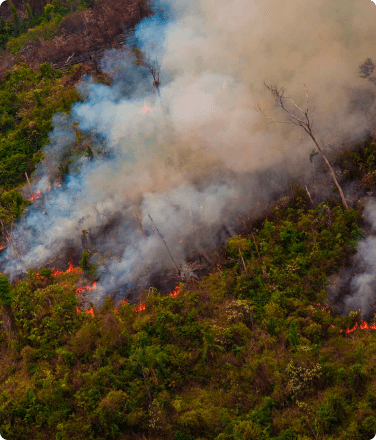The sun hovers over Loreto in Peru’s northern Amazon rainforest. IMAGE CREDIT: Anna & Michal/Flickr
By Suzanne Pelletier, Executive Director
A new report from a United Nations agency on climate change says the crisis will unavoidably worsen.
- To avoid worst-case scenarios, Rainforest Foundation US lays out a strategy that centers on the rights of indigenous forest communities.
- The strategy rests on three pillars of support to indigenous communities:
- Equipping them with forest protection technology;
- Increasing direct finance to organizations on the ground;
- Fostering stronger international relationships.
Earlier this month, the United Nations’ Intergovernmental Panel on Climate Change (IPCC) released a report forecasting climate calamity. Among the report’s most alarming findings was that the global average temperature is on track to hit 1.5° Celsius above pre-industrial levels—long considered the threshold for catastrophic ecological collapse—sometime in the next two decades. According to the report, the extreme weather events we are seeing now are bound to get worse and more frequent unless we take drastic action now.
But the IPCC’s report mustn’t be an excuse to give up the fight. It’s a clarion call to take immediate action, since the worst-case scenarios may still be avoided.
To do this, we should prioritize significant investment in proven solutions. And protecting the rights of indigenous peoples IS a proven solution.
It’s ironic to think that human rights are key in the fight against climate change, given that humans are the ones who changed the climate in the first place. But protecting the rights of some of the world’s most vulnerable is proving to be a high-impact climate solution. The science on this is clear.
Scientists estimate that nature-based solutions, including promoting healthy forests, could deliver one-third of the emission reductions the world needs to maintain a hospitable planet. As such, we need to halt deforestation and restore degraded areas—especially in tropical forests, which trap disproportionately more carbon dioxide than other forest systems. And one of the most cost-effective, immediate, and measurable ways to reduce tropical forest loss is by securing indigenous peoples’ rights to their territories.
There are countless studies that show that the territories of indigenous peoples are better protected and more carbon dense than any other protected areas, including state-protected lands. But until recently, it was unclear if that was because these communities were actively protecting these areas, or merely not laying waste to them. Indeed, the idea that indigenous communities can help save the planet might sound counterintuitive. Our media feeds us a narrative of indigenous peoples as helpless, primitive. But here too the science proves that narrative wrong.
The Proven Value of Equipping Indigenous Peoples with Technology
For several years, our organization has partnered with indigenous peoples’ representative federations to provide sophisticated–yet readily accessible–technologies to remote rainforest communities in the northern Peruvian Amazon. We believed that if these communities had access to tools like satellite data, smartphones, and drones, they could be better equipped to defend their rainforests against illegal deforesters.
A peer-reviewed study in July proved us right. In a randomized control trial study, communities that had access to these technologies were able to halve rainforest destruction in a single year compared to communities without the tech.
There’s no reason to believe that this level of impact can’t be seen across the Amazon, which is why we’re working to rapidly expand this program (called Rainforest Alert) in indigenous territories across Peru and into other countries of the Amazon. By our calculations, extending the program across all indigenous territories in the Amazon could help prevent 100 million metric tons of carbon dioxide from entering the atmosphere each year: roughly the equivalent of removing 21.4 million cars off the road.
The Growing Need for More Direct Funding To Indigenous Communities
Of course, undertaking an effort this ambitious would be costly. Which is why—as the price (and urgency) of defending our planet goes up—we need to make sure that finance gets to where it’s of best use. Too often, we hear from indigenous partners that the global rush to defend our forests is but a trickle by the time it reaches their gates. And one recent study, by our sister organization Rainforest Foundation Norway, estimates that less than 1/10th of 1% of all funds dedicated to mitigating climate change actually makes it to the indigenous communities positioned to do something.
To address the gap in financing community-based solutions, we need tools that drive direct investment to those on the ground. Rainforest Foundation US has long prioritized channeling the bulk of our operating budget to partners on the ground. But we live in a world equipped with Uber and DoorDash; there’s no reason forest protection can’t also be as straightforward and direct. We’re actively pursuing tools like these to direct as much of an individual’s donation to the indigenous organizations doing the work.
Larger scale international funds, meanwhile, should earmark a minimum of 1% of their forest protection budgets to go to indigenous communities on the frontlines of deforestation.
International Partnerships to Defend Against a Global Threat
But as localized and targeted as the funding must be, actions–especially around promoting healthy forests–need to be international. Rainforest Foundation US has been forging new partnerships and strengthening existing ones across borders for this reason. Much attention has been paid to the Amazon (the world’s largest tropical forest), but tropical forests in the Congo Basin, Indonesia, and the rest of Oceania are in equal, urgent need of protection. Not every rainforest protection and restoration solution will work in every place, but working collaboratively can ensure the best methods and strategies are tested, shared and implemented for the greatest impact.
The IPCC report makes it clear that the rainforests are one of the planet’s most precious resources. It’s imperative that we defend them. In addition to helping mitigate climate disaster, these forests are home to 80% of the world’s terrestrial biodiversity and provide livelihoods to 1.6 billion people, many of whom are amongst the world’s poorest. And the goods and services these forests provide, such as clean water and healthy soil, are integral to the continued survival of all of humanity.
That, ultimately, is what this is about: survival. We all have a role to play in ensuring the continued health of our planet. Securing indigenous peoples’ rights isn’t just generous; it’s rational and self-protective. In the urgent battle against climate change, the time is now to turn to those who have demonstrated they can lead us to proven solutions.








